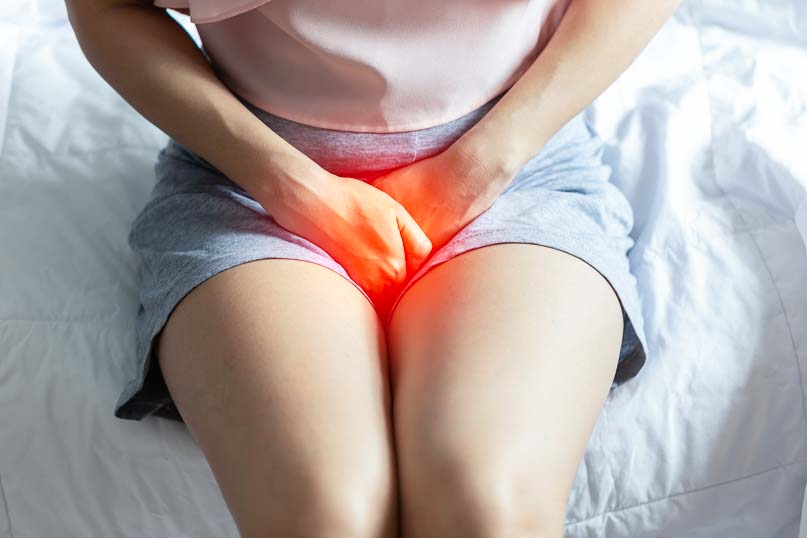Dyspareunia is a condition that affects a significant number of individuals and is defined as persistent or recurrent pain experienced during sexual intercourse. This pain can occur at various stages of sexual activity (whether at the beginning, during penetration, or even after intercourse) and it affects both women and men, although it is more prevalent in the female population.
This article delves into what dyspareunia is, what causes it, and how it can be effectively treated, with a focus on the role of pelvic floor physical therapy as a therapeutic option.
What is Dyspareunia?
Dyspareunia is described as genital pain associated with sexual intercourse that can vary in intensity and location. This pain can be localized in the vulva, vagina, clitoris, or deep pelvic region. In some cases, this condition may be confused with other issues such as vaginismus, though they are distinct. Dyspareunia is classified into two main types:
- Superficial Dyspareunia: Occurs at the onset of penetration or at the vaginal entrance, often related to infections, irritations, or anatomical abnormalities.
- Deep Dyspareunia: Felt deep within the pelvis and may be associated with internal problems such as endometriosis, pelvic inflammatory disease, or postoperative adhesions.

What Causes Dyspareunia?
The causes of dyspareunia are multifactorial and can be divided into physical, psychological, and emotional causes. Some of the most common include:
- Infections: Vaginal or urinary tract infections can cause irritation and pain during sexual intercourse.
- Endometriosis: Endometrial tissue outside the uterus can generate deep pain during intercourse. To learn more about this condition, you can read our article about Endometriosis here.
- Vaginal Dryness: Lack of lubrication, especially in postmenopausal women, is a frequent cause of superficial dyspareunia.
- Injuries or Surgeries: Scarring, poorly healed episiotomies, or surgical procedures can cause pain.
- Pelvic Floor Issues: Tension, weakness, or dysfunction of the pelvic floor muscles can significantly contribute to pain during sexual activity.
Emotional Factors: Anxiety, stress, past sexual trauma, or relationship issues can exacerbate or even cause dyspareunia.
How to Treat Dyspareunia?
Treating dyspareunia requires a multidisciplinary approach that addresses both the physical and emotional causes of the pain. One of the most effective and least invasive methods for treating dyspareunia, especially when related to muscular problems or pelvic floor dysfunctions, is Women’s Health Physiotherapy.
What Techniques Women’s Health Physio use to treats Dyspareunia?
Women’s Health Physio is a specialized discipline that focuses on the treatment and rehabilitation of the pelvic floor muscles, which are essential for urinary control, sexual function, and support of the pelvic organs. This therapy is particularly useful in treating dyspareunia, as many cases are associated with muscle dysfunction or tension in this area.
The main approaches of Women’s Health Physio for treating dyspareunia include:
- Education and Body Awareness: The first step in treatment is educating the patient about pelvic floor anatomy and how it may contribute to pain. This includes identifying points of tension or muscular dysfunctions that could be causing dyspareunia.
- Relaxation and Breathing Techniques: These techniques help reduce muscle tension and stress, both factors that can contribute to pain during sexual intercourse. Pelvic floor relaxation is essential to allow for pain-free penetration.
- Strengthening and Stretching Exercises: Depending on the diagnosis, Women’s Health Physio may include specific exercises to strengthen weakened muscles or stretch overly tight muscles. Kegel exercises are a common example, though they should be tailored and supervised by a specialized Women’s Health Physio.
- Manual Therapy: Involves hands-on techniques applied by the Physiotherapist to release tension, mobilize scars, and improve tissue elasticity.
- Biofeedback and Electrotherapy: These techniques may be used to help the patient better identify and control the pelvic floor muscles, improving function and reducing pain.

Other Complementary Treatments for Dyspareunya
In addition to Women’s Health Physio treatment, the management of dyspareunia can be complemented by:
- Vaginal Lubricants: Especially in cases of vaginal dryness.
- Hormone Therapy: For women with dyspareunia related to menopause.
- Psychology or Sex Therapy: To address psychological or emotional factors.
- Medical or Surgical Interventions: In cases where there is an underlying physical cause that requires correction.
Dyspareunya in Summary
Dyspareunia is a complex condition that can have a significant impact on the quality of life of those who experience it. The multidisciplinary approach, including Women’s Health Physio, offers a comprehensive solution to address both the physical and emotional causes of pain. It is essential that patients seek proper evaluation and treatment, as many individuals can find relief and improve their quality of life through timely and appropriate intervention.



